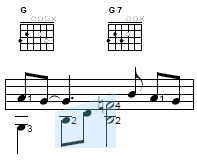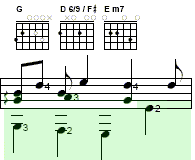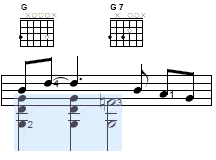[LESSON 1] - [LESSON 2] - [LESSON 3] - [LESSON 4]
Creating Fingerstyle Guitar Arrangements :: Lesson 3
The base arrangement will again be the starting point for applying new techniques to add interest to the arrangement. Hopefully the end result will be something that is fun to play and pleasing to your listening audience.


Measure 1
Chord Arpeggio
A chord arpeggio is playing notes from a chord one note at a time, normally as four 1/8th notes
over two (2) beats. In this example, that would be a bit of over kill, so it was shortened to only
three notes. Measure one (1) starts with a G chord. The
chord tones are entered from the 6th string to the 4th string as an arpeggio on beats one (1) and
two (2). See the notes highlighted in blue in measure one (1) below. To direct the listener
into hearing the chord change to G7 on beat three (3), an
F was entered as a harmony note, fret two (2) / string four
(4).

Measure 2
Mono-Tone Bass
A mono-tone bass is playing the same bass note on each beat. In measures two (2) and six
(6), the C on fret three (3) / string five (5) on beats one
(1), three (3) and four (4) is a form of mono-tone bass. Again on beat three (3), the Eb is entered to provide the chord change from C to Cm. See the
notes ;highlighted in red in measures two (2) and six (6) below.

Measure 3
Walking Bass
A walking bass is playing a different bass note on each beat. A good guideline is to continue
the direction of the notes either ascending or descending for as long as possible. In measure
three (3), the bass notes descend on string six (6) from the
G on fret three (3) to the open-E (beats 1, 2 &
3). Then it jumps up to the E on fret two (2) / string four
(4) on beat four (4). For additional flavor to the measure, some harmony notes are added to
the upper voice, all taken from the chord forms. See the notes ;highlighted in green in
measures three (2) and seven (7) below.

Measure 5
Chord Comp
The final technique used in this lesson is called a chord comp, where several notes from a chord form are played simultaneously to simulate a rhythm guitar playing a chord accompaniment. If you listen to Lenny Breau, you will hear this quite often in his arrangements. In measure five (5), triads are played on beats one (1), two (2) and three (3) to create the chord comp (note the open-G of the G7 on beat three (3) is missing in the image). If you try to arrange a song using primarily chord comp in the lower voice, try to limit the melody to the upper two (2) strings. This provides the best opportunity to use triads from the chord forms.
Play the sound clip to hear the final arrangement. The last measure was extended to include a lead-in to the song's bridge, but left up to you to finish the arrangement.

The arranging process presented in these three lessons should give you a good starting point for rolling your own. Whether you utilize a notation program or simply start noodling on your guitar, the process should be the same.
- Start with the chord progression and play the melody over the chords, adding the chord root on beats one (1) and three (3).
- After you have something that is playable, fill the voids with either additional accompaniment in the lower voice, or alternatively, you might decide to add some lead riffs in the upper voice that is played by another instrument in the recording. This was not demonstrated in these lessons.
- Remember, your arrangement will probably never be done, and most likely will be under constant modification as you discover additional possibilities.
- There are many more techniques that can be used. Listen closely to other people's arrangements to learn what they are doing. Adapt the techniques to your own arrangements whenever possible.
The tabs in TablEdit format and images are available for download:: Desperado.zip As a bonus, below is one version of a complete arrangement. The next lesson will demonstrate how to capture the essence of a recorded performance. Linda Ronstadt's version of Blue Bayou will be used, so stay tuned!!